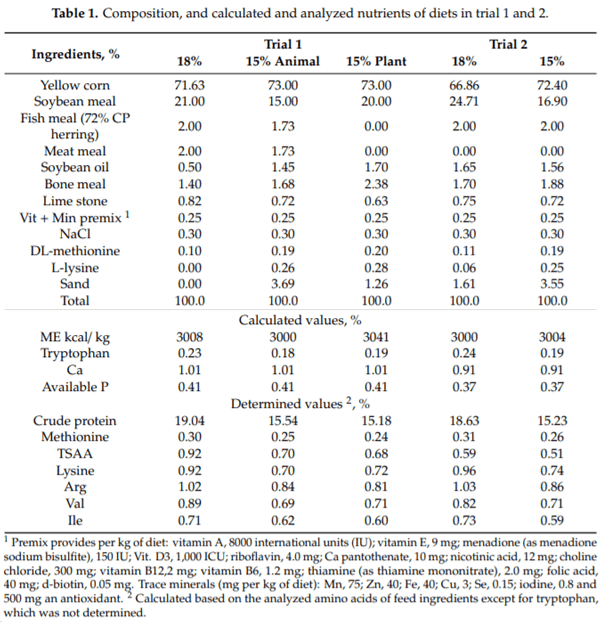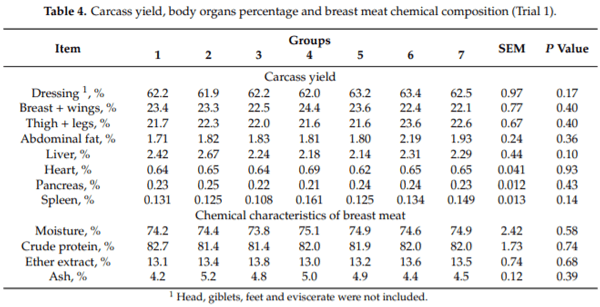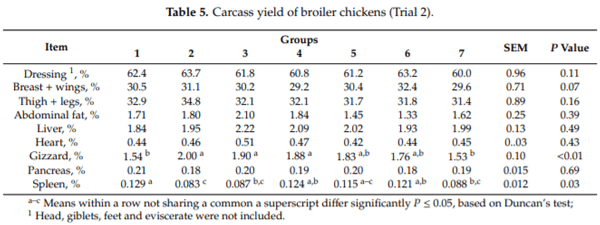Multiple Amino Acid Supplementations to Low-Protein Diets: Effect on Performance, Carcass Yield, Meat Quality and Nitrogen Excretion of Finishing Broilers under Hot Climate Conditions
Simple Summary: Crude protein is an essential nutrient in poultry feed. Reducing the use of crude protein not only reduces the feed cost, but also minimizes pollution during poultry production. Thus, finding the minimum protein requirement in broiler diet without compromising broiler growth is the objective in the present study. Supplementing essential amino acids including methionine and lysine to the low-protein diet showed comparable growth performance and carcass yield to the regular protein diet. Thus, reducing the crude protein level is possible if the essential amino acid balance is adequate for broiler growth.
Abstract: The objective of this study was to evaluate the effect of low-protein diets with amino acid supplementation on growth performance, carcass yield, meat quality and nitrogen excretion of broilers raised under hot climate conditions during the finisher period. In trial 1, broilers from 28 to 49 days of age were fed 18% crude protein (CP) as a positive control or 15% CP supplemented with (1) DL-methionine (Met) + L-lysine (Lys), (2) Met + Lys + L-Arginine (Arg), or (3) Met + Lys + L-Valine (Val). In trial 2, broilers from 30 to 45 days of age, were fed an 18% CP diet as a positive control or 15% CP supplemented with Met, Lys, Arg, Val, L-Isoleucine (Ile) or combination with glycine (Gly) and/or urea as nitrogen sources: (1) Met + Lys, (2) Met + Lys + Arg, (3) Met + Lys + Val, (4) Met + Lys + Ile, (5) Met + Lys + Arg +Val + Ile + Gly, and (6) Met+ Lys + Arg + Val + Ile + Gly + urea. Protein use was improved by feeding low-protein amino acid-supplemented diets as compared to the high-protein diet. Feeding 15% crude protein diet supplemented with only methionine and lysine had no negative effects on carcass yield, CP, total lipids and moisture% of breast meat while decreasing nitrogen excretion by 21%.
Keywords: broilers; amino acid; low crude protein; carcass yield; nitrogen excretion; hot climate.
Animals 2020, 10, 973; doi:10.3390/ani10060973.





- Attia, Y.A.; Böhmer, B.M.; Roth-Maier, D.A. Responses of broiler chicks raised under constant relatively high ambient temperature to enzymes, amino acid supplementations, or diet density. Archive Für Geflügelkunde 2006, 70, 80–91.
- Attia, Y.A.; Hassan, R.A.; Tag El-Din, A.E.; Abou-Shehema, B.M. E ect of ascorbic acid or increasing metabolizable energy level with or without supplementation of some essential amino acids on productive and physiological traits of slow-growing chicks exposed to chronic heat stress. J. Anim. Physiol. Anim. Nutr. 2011, 95, 744–755. [CrossRef] [PubMed]
- Dozier, W.A.; Kidd, M.T.; Corzo, A. Dietary amino acid responses of broiler chickens. J. Appl. Poult. Res. 2008, 17, 157–167. [CrossRef]
- Kim, J.H.; Patterson, P.H.; Kim, W.K. Impact of dietary crude protein, synthetic amino acid and keto acid formulation on nitrogen excretion. Int. J. Poult. Sci. 2014, 13, 429–436. [CrossRef]
- Chalova, V.I.; Kim, J.H.; Patterson, P.H.; Ricke, S.C.; Kim, W.K. Reduction of nitrogen excretion and emissions from poultry: A review for conventional poultry. World’s Poult. Sci. J. 2016, 72, 509–520. [CrossRef]
- Fancher, B.I.; Jensen, L.S. Dietary protein level and essential amino acid content: Influence upon female broiler performance during the grower period. Poult. Sci. 1989, 68, 897–908. [CrossRef]
- Han, Y.; Suzuki, H.; Parsons, C.M.; Baker, H. Amino acid fortification of a low-protein corn and soybean meal diet for chicks. Poult. Sci. 1992, 71, 1168–1178. [CrossRef]
- Laudadio, V.; Dambrosio, A.; Normanno, G.; Khan, R.U.; Naz, S.; Rowghani, E.; Tufarelli, V.; Bunchasak, C.U.; Tanaka, S.K.; Ohtani, S.; et al. The e ect of supplementing methionine plus cystine to a low-protein diet on the growth performance and fat accumulation of growing broiler chicks. Asian-Australas. J. Anim. Sci. 1997, 10, 185–191.
- Alleman, F.; Michel, J.; Chagneau, A.M.; Leclercq, B. The e ects of dietary protein independent of essential amino acids on growth and body composition in genetically lean and fat chickens. Br. Poult. Sci. 2000, 41, 214–218. [CrossRef]
- Aletor, V.A.; Hamid, I.I.; Niess, E.; Pfe er, E. Low-protein amino acids-supplemented diets in broiler-chickens: E ects on performance, carcass characteristics whole-body–composition and e ciencies of nutrient utilization. J. Sci. Food Agric. 2000, 80, 547–554. [CrossRef]
- Aletor, V.A.; Roth, F.X.; Paulicks, B.R.; Roth-Maier, D.A. Growth, body-fat deposition, nitrogen excretion and e ciencies of nutrients utilization in broiler-chicks fed low-protein diets supplemented with amino acids, conjugated linoleic acid or an -glucosidase inhibitor. Archive Geflügelk 2001, 66, 21–30.
- Laudadio, V.; Dambrosio, A.; Normanno, G.; Khan, R.U.; Naz, S.; Rowghani, E.; Tufarelli, V. E ect of reducing dietary protein level on performance responses and some microbiological aspects of broiler chickens under summer environmental conditions. Avian Biol. Res. 2012, 5, 88–92. [CrossRef]
- McGill, E.; Kamyab, A.; Firman, J.D. Low crude protein corn and soybean meal diets with amino acid supplementation for broilers in the starter period. 1. E ects of feeding 15% crude protein. Int. J. Poult. Sci. 2012, 11, 161–165.
- McGill, E.; Kamyab, A.; Firman, J.D. Low crude protein corn and soybean meal diets with amino acid supplementation for broilers in the starter period. 2. E ects of feeding 13% crude protein. Int. J. Poult. Sci. 2012, 11, 166–171.
- Scott, M.L.; Nesheim, M.C.; Young, R.J. Nutrition of the Chicken, 3rd ed.; M. L. Scott and Associates: Ithaca, NY, USA, 1982.
- Fernandez, S.R.; Aoyagi, S.; Han, Y.; Parsons, C.; Baker, D.H. Limiting order of amino acids in corn and soybean meal for growth of the chick. Poult. Sci. 1994, 73, 1887–1896. [CrossRef]
- Baker, D.M. Problems and pitfalls in animal experiments designed to establish dietary requirements for essential nutrients. J. Nutr. 1986, 116, 2339–2349. [CrossRef]
- Liu, N.; Wang, J.Q.; Gu, K.T.; Deng, Q.Q.; Wang, J.P. E ects of dietary protein levels and multienzyme supplementation on growth performance and markers of gut health of broilers fed a miscellaneous meal based diet. Anim. Feed Sci. Technol. 2017, 234, 110–117. [CrossRef]
- Holsheimer, J.P.; Janssen, W.M.M.A. Limiting amino acids in low protein maize-soybean meal diets fed to broiler chicks from 3 to 7 weeks of age. Br. Poult. Sci. 1991, 32, 151–158. [CrossRef]
- Lipstein, B.; Bornstein, S.; Bartov, I. The replacement of some of the soybean meal by the first limiting amino acids in practical broiler diets. 3. E ects of protein concentration and amino acid supplementation in broiler finisher diets on fat deposition on the carcass. Br. Poult. Sci. 1975, 16, 627–635. [CrossRef]
- Leclercq, B.; Chagneau, A.M.; Cochard, T.; Khoury, J. Comparative responses of genetically lean and fat chickens to lysine, arginine and non-essential amino acid supply. I. Growth and body composition. Br. Poult. Sci. 1994, 35, 687–696. [CrossRef]
- Sterling, K.G.; Costa, E.F.; Henry, M.H.; Pesti, G.M.; Bakalli, R.I. Responses of broiler chickens to cottonseed and soybean meal-based diets at several protein levels. Poult. Sci. 2002, 81, 217–226. [CrossRef] [PubMed]
- Xie, M.; Jiang, Y.; Tang, J.; Wen, Z.G.; Zhang, Q.; Huang, W.; Hou, S.S. E ects of low-protein diets on growth performance and carcass yield of growing White Pekin ducks. Poult. Sci. 2017, 96, 1370–1375. [CrossRef] [PubMed]
- Ospina-Rojas, I.C.; Murakami, A.E.; Duarte, C.R.A.; Eyng, C.; Oliveira, A.L.; Janeiro, V. Valine, isoleucine, arginine and glycine supplementation of low-protein diets for broiler chickens during the starter and grower phases. Br. Poult. Sci. 2014, 55, 766–773. [CrossRef] [PubMed]
- National Research Council (NRC). Nutrient Requirements of Poultry, 9th ed.; National Academy of Sciences, National Research Council: Washington, DC, USA, 1994.
- Association O cial Analytical Chemistry (AOAC). O cial Methods of Analysis, 19th ed.; Association O cial Analytical Chemistry: Washington, DC, USA, 2007.
- SAS Institute. SASfiUser’s Guide for Personal Computer; SAS Institute Inc.: Cary, NC, USA, 2007.
- Attia, Y.A.; Al-Harthi, M.A.; Hassan, S.S. Turmeric (Curcuma longa Linn.) as a phytogenic growth promoter alternative for antibiotic and comparable to mannan oligosaccharides for broiler chicks. Rev. Mex. Cienc. Pecu. 2017, 8, 11–21. [CrossRef]
- Quinteiro-Filho, W.M.; Ribeiro, A.; Ferraz-de-Paula, V.; Pinheiro, M.L.; Sakai, M.; Sá, L.R.M.D.; Palermo-Neto, J. Heat stress impairs performance parameters, induces intestinal injury, and decreases macrophage activity in broiler chickens. Poult. Sci. 2010, 89, 1905–1914. [CrossRef]
- Chrystal, P.V.; Moss, A.F.; Khoddami, A.; Naranjo, V.D.; Selle, P.H.; Liu, S.Y. Impacts of reduced-crude protein diets on key parameters in male broiler chickens o ered maize-based diets. Poult. Sci. 2020, 99, 505–516. [CrossRef]
- Van Harn, J.; Dijkslag, M.A.; van Krimpen, M.M. E ect of low protein diets supplemented with free amino acids on growth performance, slaughter yield, litter quality, and footpad lesions of male broilers. Poult. Sci. 2019, 98, 4868–4877. [CrossRef]
- Smith, R.E. Assessment of the availability of the amino acid in fish meal, soybean meal and feather meal by chick growth assay. Poult. Sci. 1968, 47, 1624. [CrossRef]
- Miller, D.; Kifer, R.R. Factors a ecting protein evaluation of fish meal by chick bioassay. Poult. Sci. 1970, 49, 999–1004. [CrossRef]
- Ravindran, V.; Hew, L.; Ravindran, G.; Bryden, W. Apparent ileal digestibility of amino acids in dietary ingredients for broiler chickens. Anim. Sci. 2005, 81, 85–97. [CrossRef]
- Han, Y.; Baker, D.H. E ects of sex, heat stress, body weight and genetic strain on the lysine requirement of broiler chicks. Poult. Sci. 1993, 72, 701–708. [CrossRef] [PubMed]
- Han, Y.; Baker, D.H. Lysine requirement of fast and slow growing broiler chicks. Poult. Sci. 1991, 70, 2108–2114. [CrossRef] [PubMed]
- Aggoor, F.A.M.; El-Naggar, N.M.; Mehrez, A.Z.; Attia, Y.A.; Qota, E.M.A. E ect of di erent dietary protein and energy levels during roaster period on: 1-Performance and economic evaluation of broiler chicks. Egypt. Poult. Sci. 1997, 17, 81–105.
- Costa, M.J.; Da Zaragoza-Santacruz, S.; Frost, T.J.; Halley, J.; Pesti, G.M. Straight-run vs. sex separate rearing for 2 broiler genetic lines Part 1: Live production parameters, carcass yield, and feeding behavior. Poult. Sci. 2017, 96, 2641–2661. [CrossRef]
- Waguespack, A.M.; Powell, S.; Bidner, T.D.; Payne, R.L.; Southern, L.L. E ect of incremental levels of L-lysine and determination of the limiting amino acids in low crude protein corn-soybean meal diets for broilers. Poult. Sci. 2009, 88, 1216–1226. [CrossRef]
- Warnick, R.E.; Anderson, J.O. Limiting essential amino acids in soybean meal for growing chickens and the e ects of heat upon availability of the essential amino acids. Poult. Sci. 1968, 47, 281–287. [CrossRef]
- Schwartz, R.W.; Bray, D.J. Limiting amino acids in 40:60 and 15:85 blends of corn: Soybean protein for the chicks. Poult. Sci. 1975, 54, 1814.
- Uzu, G. Limit of reduction of the protein level in broiler feeds. Poult. Sci. 1982, 61, 1557–1558.
- Shao, D.; Shen, Y.; Zhao, X.; Wang, Q.; Hu, Y.; Shi, S.; Tong, H. Low-protein diets with balanced amino acids reduce nitrogen excretion and foot pad dermatitis without a ecting the growth performance and meat quality of free-range yellow broilers. Ital. J. Anim. Sci. 2018, 17, 698–705. [CrossRef]
- Jensen, L.S.; Mendonca, C.X. Amino acid nutrition of broilers during the grower period. In Georgia Nutrition Conference for the Feed Industry; University of Georgia: Athens, GA, USA, 1988; pp. 76–83.
- D’Mello, J.P.E. (Ed.) Amino acid imbalances, antagonisms and toxicities. In Amino Acid in Farm Animal Nutrition; CAB International: Wallingford, UK, 1994; pp. 63–98.
- Awad, E.A.; Zulkifli, I.; Soleimani, A.F.; Loh, T.C. Individual non-essential amino acids fortification of a low-protein diet for broilers under hot and humid tropical climate. Poult. Sci. 2014, 94, 2772–2777. [CrossRef]
- Dean, D.W.; Bidner, T.D.; Southern, L.L. Glycine supplementation to low protein, amino acid-supplemented diets supports optimal performance of broiler chicks. Poult. Sci. 2006, 85, 288–296. [CrossRef] [PubMed]
- El-Boushy, A.R. Broiler growth response from practical low-protein diets supplemented with urea and diammonium hydrogen phosphate. Neth. J. Agric. Sci. 1980, 28, 147–155.
- Kagan, A.; Balloun, S.L. Urea and aspartic acid supplementation of low-protein broiler diets. Br. Poult. Sci. 1976, 17, 403–413. [CrossRef] [PubMed]
- Aletor, V.A.; Eder, K.; Becker, K.; Paulicks, B.R.; Roth, F.X.; Roth-Maier, D.A. The e ects of conjugated linoleic acids or an alpha-glucosidase inhibitor on tissue lipid concentrations and fatty acid composition of broiler chicks fed a low-protein diet. Poult. Sci. 2003, 82, 796–804. [CrossRef]
- Alleman, F.; Leclercq, B. E ect of dietary protein and environmental temperature on growth performance and water intake of male broiler chickens. Poult. Sci. 1997, 38, 607–610. [CrossRef]
- Jacob, J.; Blair, R.; Ibrahim, S.; Scott, T.; Newberry, R. Using reduced protein diets to minimize nitrogen excretion of broilers. Poult. Sci. 1995, 74 (Suppl. 1), 127.
- Nahashon, S.M.; Bartlett, J.R.; Smith, E.J. Responses to dietary crude protein and energy levels by cross of chickens involving White Plymouth Rock. Poult. Sci. 1995, 74 (Suppl. 1), 207.
- Hegedüs, M. Dietary factors influencing protein utilization: A review. Acta Vet. Hung. 1992, 40, 133–143.
- Moran, E.T.; Bushong, R.D.; Bilgili, S.F. Reducing dietary crude protein for broilers while satisfying amino acid requirements by least-cost formulation: Live performance, litter composition, and yield of fast-food carcass cute of six weeks. Poult. Sci. 1992, 71, 1687–1694. [CrossRef]
- Keshavarz, K.; Austic, R.E. The use of low-protein, low-phosphorus, amino acid- and phytase-supplemented diets on laying hens performance and nitrogen and phosphorus excretion. Poult. Sci. 2004, 83, 75–83. [CrossRef]
- Leclercq, B. The influence of dietary protein content on the performance of genetically lean or fat growing chickens. Br. Poult. Sci. 1983, 24, 581–587. [CrossRef] [PubMed]
- Cahaner, A.; Leenstra, F. E ects of high temperature on growth and e ciency of male and female broilers from lines selected for high weight gain, favorable Feed conversion, and high or low fat content. Poult. Sci. 1992, 71, 1237–1250. [CrossRef] [PubMed]
- Smith, E.R.; Pesti, G.M.; Bakalli, R.I.; Ware, G.O.; Menten, J.F.M. Further studies on the influence of genotype and dietary protein on the performance of broilers. Poult. Sci. 1998, 77, 1678–1687. [CrossRef] [PubMed]
Summarizing my opinion, with the results obtained in this study, where a diet with 15% protein supplemented with the amino acids methionine and lysine provided a performance result of chickens similar to that obtained with the diet with 18% protein, it does not make sense to propose further study. in this line of research in order to assess the possible deficiency of any other amino acid. I think that based on your results, it would be more appropriate to implement a survey to assess the protein requirement of chickens subjected to the 35 ºC environment. After conducting this study as the first experiment, it would be worth evaluating BP reduction with supplementation of Aas.
I am very happy that the paper opened this favorable discussion and stimulates further research.
Youssef Attia, I don't think I made myself understood yet. In the case of her study, it was evidenced that, since her diet with 15% CP supplemented with methionine and lysine for having resulted in the same performance of the birds receiving the diet with 18% CP, she would not be deficient in any other Aas. In this case, I would not be surprised if your diet with 15% CP with supplementation only of methionine, to reach a level compatible with that of 15% CP, would not be enough to promote similar performance of the birds achieved with the 18% diet PB. I reaffirm that in my opinion the fact that a very high temperature was used for the chickens in the evaluated phase, made it impossible to better assess their hypotheses. From your results, you still have doubts that your diet with 15% of CP with adjustment only of the level of methionine, making it compatible for this level of CP, not for the level of 18% of CP, would be sufficient to maintain the level of performance achieved with the 15% CP diet plus the two amino acids methionine and lysine. I will not insist on my point of view on this matter.
RAMI SEBAI, although not a member of the team of researchers at work, decided to state my point of view about his questioning due to my considerations about the study in question. In fact, when I associated the lack of difference in bird performance between treatments, due to the possible deficiency of a third limiter, in this case tryptophan, it was a mere example. This should take place in an environment of less stressful temperature for the birds. I agree with your proposal that under normal conditions, even under stress conditions due to less extreme temperature, the third limiting Aas could be threonine. It turns out that the fact that the diet with 15% CP, provided birds performance similar to that observed with the diet with 18% CP, invalidates the suggestion of the possibility of the possible deficiency of a third Aas. This was the reason why we proposed that the temperature used was very high, which changed the pattern of amino acid requirement of the birds. This being the factor responsible for the non-difference of birds between treatments with 18% and 5% CP.
Youssef Attia, More objectively, my considerations aimed to substantiate the doubts I have regarding its results;
- FIRST; it did not make sense to me that the birds that received the diet with 15% crude protein (CP) supplemented with methionine and lysine performed similarly to those that received the diet with 18% CP. This pattern of performance of the birds that occurred between these two diets, seems to me to be more reasonable to consider that the temperature used at work, was very high for the birds, which certainly changed their amino acid requirements (Aas) to lower values.- SECOND ; neither did it seem reasonable to me that diets with a 3% reduction in CP level were deficient only in methionine and lysine. This if 18% of CP represents the real requirement of the birds, which I do not believe. - THIRD; under normal conditions, it should be considered that birds respond positively to AaS supplementation only in the correct order of sequential deficiency. For example, in the case of its results, in which supplementation of different combinations of Aas did not result in improved performance of the birds, it could be justified by the fact that the third Aas deficient in their diets with 15% CP with addition of methionine and lysine, it could be an Aas that was not being tested. In your study, for example it could be tryptophan. In this case, birds would not respond to supplementation with any other Aas. This last consideration would be evident in his work, if the diet with 15% CP plus methionine and lysine did not provide similar performance results for the birds that received the 18% CP diet.
Youssef Attia, consistent results regarding the low growth rate of the birds. However, I would like to make some considerations; - not being able to check if the temperatures of the two periods evaluated were fixed.;
- Regardless, as it was used a very high temperature for the ages of the birds in both periods, I think it was necessary to include a treatment in which it was the level of 15% of CP without any supplementation of amino acids was evaluated. I believe that only using this treatment could I conclude the need for supplementation of lysine and methionine.
- Finally, I would like to consider that if temperatures were kept fixed, the performance results, consistently because they are very low, may have interfered in the pattern of response of birds to the amino acid levels of feed, which may compromise the study's conclusions.
Interesting topic. We at Anthem also had such experience with our Chirally and bioavailable form of vitamins.
We have tried flagship products L methyl folate, Pyridoxal 5 phosphate, Menaquinone derivatives, etc., as part of feed composition as top addition in ppm quantities. We found exiting results in terms of growth, higher immunity and less mortality.
We understand that such bioavailable forms of vitamins have so positive impact, it is food for thought for the users to try them commercially over standard regular vitamins.
Nevertheless Vitamins and proteins are the building blocks and hugely needed for overall performance.





.jpg&w=3840&q=75)











.jpg&w=3840&q=75)